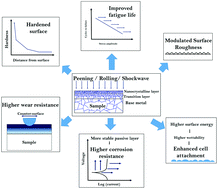Review of recent developments in surface nanocrystallization of metallic biomaterials
Abstract
Metallic materials are widely used to prepare implants for both short-term and long-term use in the human body. The performance of these implants is greatly influenced by their surface characteristics, which has motivated the development of several surface modification techniques. Surface severe plastic deformation (S2PD) techniques have emerged as promising strategies to enhance the performance of metallic biomaterials. They do not involve chemical modification of the surface and impart minimal changes to the surface topography. S2PD processes are based on the principle of generating nanocrystals at the surface, which can improve performance metrics, such as fatigue, wear, corrosion resistance, and biocompatibility through various mechanisms, such as surface hardening and alterations to the surface oxide layer. This review presents the state of the art on the development of different S2PD processes and their applications on metallic biomaterials. Brief descriptions of the different processes have been provided, followed by a discussion on the microstructural changes induced by these processes for different generations of biomaterials. The effect of S2PD on surface and bulk characteristics of the biomaterials and their performance is critically reviewed. As an emerging class of surface engineering techniques in biomaterials science, more work is needed to fully leverage their potential in this field, and these opportunities are discussed in this review.

- This article is part of the themed collection: Recent Review Articles


 Please wait while we load your content...
Please wait while we load your content...